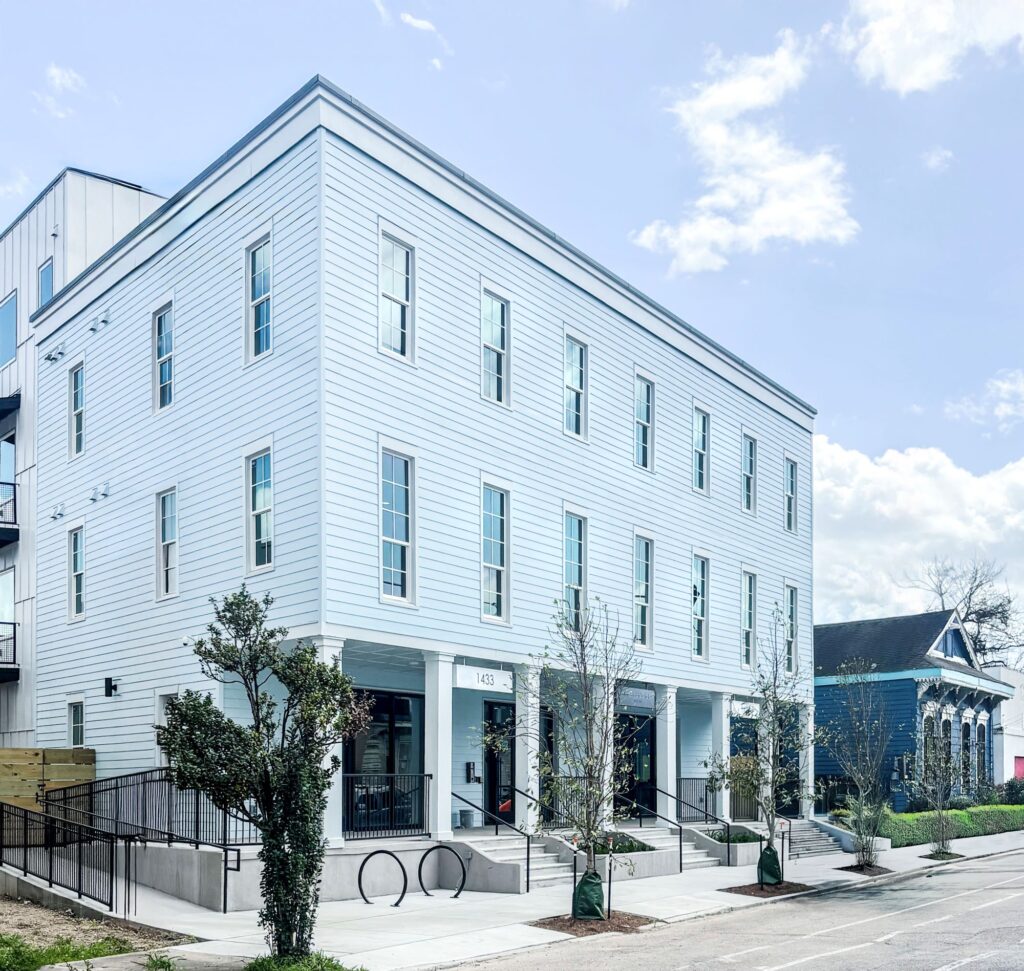In New Orleans, a Long-Awaited Answer to Katrina-Shuttered Public Housing

By Mark Fogarty
7 min read
With the opening of the St. Bernard Circle Apartments in New Orleans, another piece of an expansive Department of Housing and Urban Development (HUD) Choice Neighborhoods Initiative (CNI) grant to revitalize public housing in the city has been implemented. And, with the use of resiliency standards for hurricanes and flooding, project developers aim to ensure the housing remains for a long time.
The project comes as a result of a 2021 RFP from the New Orleans Redevelopment Authority (NORA) as a continuation of the Housing Authority of New Orleans’ (HANO) long-term work in the culturally rich neighborhood. The RFP specifically called for a mixed-use project with ground-floor commercial space that also prioritized disaster resiliency, energy efficiency, and community-oriented improvements, such as a local community park. These priorities combined to “focus on promoting the rich cultural fabric of New Orleans’ 7th Ward,” says Chris Clement, senior vice president of developer HRI Communities.
According to Clement, HRI and its partner, New Orleans Restoration Properties (NORP), were selected in August 2021 and promptly began designing the project and securing financing. They secured $14 million in nine percent Low Income Housing Tax Credit (LIHTC) equity through Hudson Housing Capital, as well as another $6 million from the City of New Orleans in subordinate HOME funds and GO bond proceeds, plus a $450,000 grant from the Ford Foundation. The project also received construction financing from Capital One and a $2 million permanent loan from Hope Federal Credit Union, allowing for an October 2023 closing. The total development cost was $22.5 million.

St. Bernard Circle officially opened in April 2025, capping off another portion of HUD’s wider CNI plans to provide a one-for-one replacement of 821 public-housing units in the former Iberville Projects, a 1940s-era public housing development that sat on a 23-acre site just blocks from the city’s historic French Quarter. Unlike much of the housing in New Orleans, the Iberville site did not flood in 2005 due to Hurricane Katrina. However, it was still shuttered in the years following the storm, as, according to Clement, the sprawling complex had long been identified by city leaders as a target for redevelopment to address deteriorating conditions and spur reinvestment in the surrounding Tremé neighborhood.
Amid a growing post-disaster housing crisis, “the City of New Orleans and the Housing Authority of New Orleans were able to receive one of the first CNI Implementation Grant awards for $30.5 million back in August of 2011,” Clement says. Since then, the Iberville/Tremé CNI program, which involves a holistic approach to community revitalization, “has been a tremendous success on all fronts,” he says.
Sixteen of the 51 total units at St. Bernard Circle will be included in the CNI replacements for the former Iberville units. Clement says that the St. Bernard Circle project is part of a broader push for reinvestment into the neighborhoods surrounding Iberville, which include hundreds of new affordable and market-rate housing units, an extended streetcar line, a newly developed LSU hospital, and renovations of historic hotels and theaters in the tourist-friendly area.
Though the CNI is not yet complete, its finished projects have “transformed the neighborhood,” Clement says. “The St. Bernard Circle is the most recent development that, in exchange for receiving project-based voucher (PBV) assistance, was able to provide replacement units that count towards the overall CNI goal.”
Prioritizing Disaster Resiliency
One additional requirement was disaster resiliency in hurricane-prone New Orleans.
“Nobody is spared the risk or impact of natural disasters,” Clement says. “Unfortunately, New Orleans has been ground zero for some of the most devastating hurricane impacts that the country has ever seen. And what happens in a hurricane is that the most vulnerable people, living in affordable or mixed-income housing, seem to be the most impacted.”
There’s no such thing as a hurricane-proof building, Clement says. “But we can take measures to ensure that the impact of the storm does not shut the building down.”
This includes using what Clement calls “flood-hardy” materials. “On your lowest floors, you use materials that, in the unfortunate instance of a flood, you don’t have to gut the entire building and let it dry out. Rather than sheet rock on the walls, you have Hardie boards (a type of water-resistant fiber/cement siding). Rather than fiberglass insulation, you have closed-cell foam insulation.” These building techniques, alongside significant use of concrete, masonry, and steel, and inclusion of backup generators in cases of power loss, allow residents to recover more quickly from potential flooding or hurricane damage to their buildings.
St. Bernard’s focus on resiliency netted a FORTIFIED Gold certification, a construction quality standard that has expanded in recent years to include multifamily housing. Clement says that achieving the FORTIFIED rating was “the right thing to do. It’s the smartest way to build.”
The four-story project includes 36 one-bedroom and 15 two-bedroom apartments. Forty of the 51 units are affordable at 60 percent or less of area median income, with some as low as 20 percent. The remaining 11 are true market-rate rentals. The 16 “replacement” units as part of the CNI grant will fall under the Housing Authority of New Orleans’ PBV program; three of those units will be allocated towards Permanent Supportive Housing.
Clement notes that the market-rate units are dispersed throughout the building and that the affordable units offer the same amenities as the market-rate units. These amenities include secure off-street parking for vehicles and bicycles, a community center, a fitness center, and a publicly accessible green space featuring a park with public art by local artists and a stage for cultural events.
Additionally, the building features 1,866 square feet of ground-floor retail space. “The retail spaces have been leased to community-minded, minority-owned businesses, Nola by Nature and Gr8tful Events,” HRI wrote in a separate statement.
The design-build team consisted of Landis Construction as the General Contractor, HCI Architecture as the Architect of Record, and ILSI Engineering as the Civil and Stormwater Management Engineer. HRI Management will operate the property.
In addition to its FORTIFIED Gold designation, St. Bernard Circle also meets Enterprise’s Green Communities sustainability standards.
FORTIFIED Rating Expanded
to Include Multifamily
FORTIFIED is a voluntary construction standard that strengthens homes and commercial buildings against severe weather, such as high winds, hail, or hurricanes. Offered by the Insurance Institute for Business & Home Safety (IBHS) since 2010, the program has expanded in recent years to include multifamily projects, such as the St. Bernard Circle Apartments in New Orleans, LA.
The program not only provides a standard for resilience in severe weather but also can help net insurance discounts for FORTIFIED-designated properties in certain states, says Fred Malik, managing director for FORTIFIED. “FORTIFIED reduces property loss and keeps people in their homes,” he says.
“It all starts with the roof,” Malik explains, emphasizing the structural component’s year-round exposure. “If it is damaged or compromised, a traditional roof will allow water to migrate into the building and create a situation where occupants may not be able to stay.” Malik says that FORTIFIED’s roof requirements are primarily concerned with securing the roof deck, making sure gaps in the deck are sealed, and that the edges are locked down.
St. Bernard Circle has a parapet—a common wall that extends above the roofline—which Malek says requires special consideration. “We make sure that the parapet is adequately built, the flashing that’s on top of that is connected well, and we also pay attention to how the roof-mounted equipment is installed.” (Flashing is designed to cut off pathways for water to get into the building.)
Once the roof has been fortified, “the next logical step is to address the building envelope. That’s things like doors, windows, and any attached structures you might have, such as how a garage in the building is protected.”
To achieve a “Gold” standard, a structure must have a FORTIFIED-eligible roof and building envelope, plus raised, flood-resistant utility lines and an engineered continuous load path (the anchoring system that ties a building to its foundation and transfers all loads applied to the building in high wind).
Of the St. Bernard project, Malek says that it “was built with intentionality to keep water out, wherever it might get in.” As with all FORTIFIED-designated projects, St. Bernard had to go through an independent third-party review, which IBHS then approved.